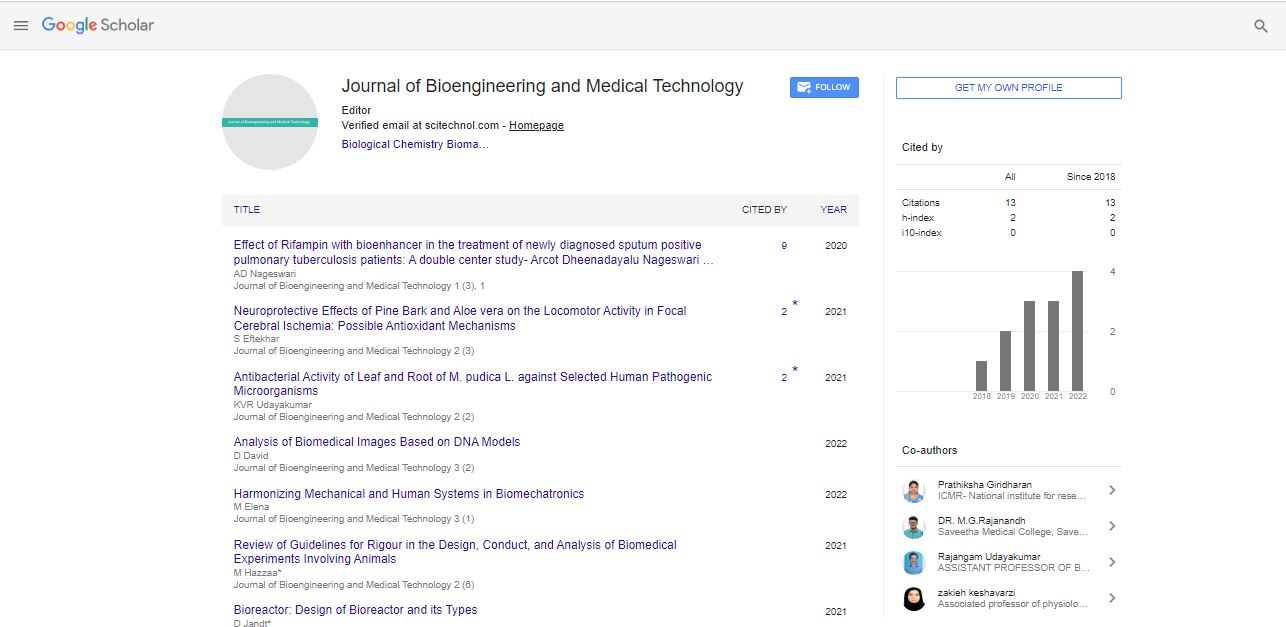Commentary, J Bioeng Med Technol Vol: 4 Issue: 3
Diagnostic Radiology: Transforming Healthcare through Precision Imaging
Karen Pedersen*
1Department of Radiology, University Hospital of Southern Denmark, Beriderbakken, Denmark
*Corresponding Author: Karen Pedersen,
Department of Radiology, University
Hospital of Southern Denmark, Beriderbakken, Denmark
E-mail: pedersenkaren@gmail.com
Received date: 28 August, 2023, Manuscript No. JBMT-23-118399;
Editor assigned date: 30 August, 2023, PreQC No. JBMT-23-118399 (PQ);
Reviewed date: 13 September, 2023, QC No. JBMT-23-118399;
Revised date: 20 September, 2023, Manuscript No. JBMT-23-118399 (R);
Published date: 27 September, 2023, DOI: 10.4172/JBMT.1000075
Citation: Pedersen K (2023) Diagnostic Radiology: Transforming Healthcare through Precision Imaging. J Bioeng Med Technol 4:3.
Description
Diagnostic radiology, a pivotal component of modern healthcare, utilizes medical imaging techniques to visualize the interior of the body for diagnosis and treatment planning. Diagnostic radiology is a branch of medical science that employs various imaging techniques to investigate the human body's internal structures, enabling healthcare providers to diagnose and treat diseases. Over the years, it has undergone significant evolution, moving from rudimentary X-rays to highly advanced modalities that provide intricate details of the human anatomy.
Historical development
The history of diagnostic radiology dates back to Wilhelm Conrad Roentgen's discovery of X-rays in 1895. This innovative innovation paved the way for non-invasive imaging, transforming medical practice. Radiography quickly became an essential diagnostic tool for examining bones and soft tissues, and its application expanded to include Computed Tomography (CT), Magnetic Resonance Imaging (MRI), ultrasound, and nuclear medicine.
Diagnostic imaging modalities
Modern diagnostic radiology encompasses a multitude of imaging modalities, each suited to different clinical scenarios:
• Utilizes ionizing radiation to create 2D images, commonly used for bone and chest imaging.
• Provides cross-sectional images for detailed anatomical assessment.
• Uses magnetic fields and radio waves to produce high-resolution images, particularly valuable for soft tissue evaluation.
• Relies on sound waves to visualize structures within the body, frequently used in obstetrics and cardiology.
• Involves the administration of radiopharmaceuticals to assess organ function and detect disease.
• Real-time X-ray imaging, important for procedures like angiography and barium studies.
Advancements in diagnostic radiology
Advancements in diagnostic radiology have led to improved image quality, reduced radiation exposure, and enhanced diagnostic accuracy. Digital radiography has largely replaced conventional film-based systems, offering immediate image acquisition and manipulation. Dual-energy CT enables the visualization of tissues with different densities. Contrast agents are now safer and more effective. MR imaging has evolved to achieve higher resolution, and the development of functional MRI has enhanced our understanding of brain function.
Role in disease detection and treatment planning
Diagnostic radiology plays a central role in disease detection and the formulation of treatment plans. It is indispensable in oncology, where it aids in tumor staging, treatment response assessment, and radiation therapy planning. In cardiology, diagnostic imaging helps evaluate cardiac function and vascular diseases. In neurology, it assists in diagnosing stroke, multiple sclerosis, and traumatic brain injuries. The field of musculoskeletal radiology is essential for diagnosing orthopedic conditions and guiding joint injections.
Artificial Intelligence (AI) in radiology
Artificial intelligence is revolutionizing diagnostic radiology. Machine learning algorithms are being employed to analyze medical images, speeding up diagnosis and enhancing accuracy. AI can assist in the detection of abnormalities, segmentation of organs, and even predict disease outcomes. The integration of AI into radiology promises to optimize workflows, reduce errors, and improve patient care.
Future trends
The future of diagnostic radiology is promising. Some anticipated trends include:
• Tailoring imaging protocols to individual patient characteristics.
• Combining multiple modalities for more comprehensive assessments.
• Expanding the use of handheld ultrasound devices.
• Emphasizing the quantitative analysis of image data.
• Extracting advanced information from medical images to inform treatment decisions.
Diagnostic radiology is an indispensable cornerstone of modern healthcare, transforming the way diseases are detected and treated. Its evolution from X-rays to an array of sophisticated imaging modalities, coupled with the integration of artificial intelligence, has paved the way for more precise and personalized patient care. As the field continues to evolve, the future promises even more advanced diagnostic tools and techniques, further enhancing our ability to diagnose and treat a wide range of medical conditions.
 Spanish
Spanish  Chinese
Chinese  Russian
Russian  German
German  French
French  Japanese
Japanese  Portuguese
Portuguese  Hindi
Hindi 
